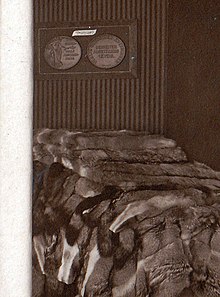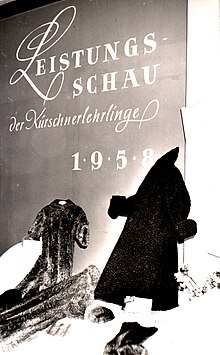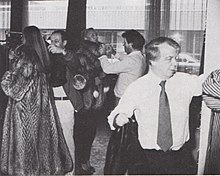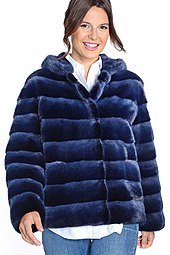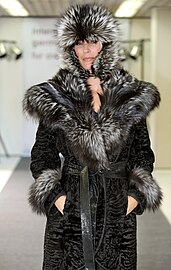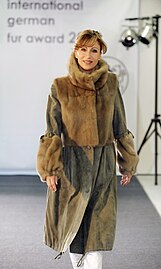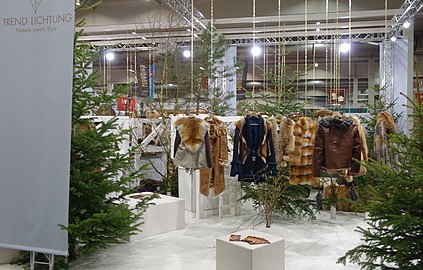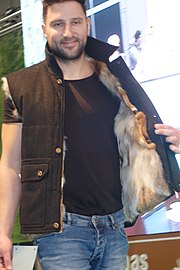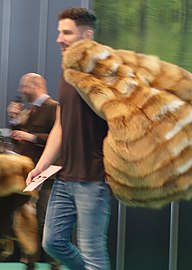International design competition of the German furrier trade
The International Design Competition of the German Furrier Handicraft is a performance competition for fur- producing handicraft businesses organized by the Central Association of the Furrier Handicraft since 1949 . Forerunners were the novelty exhibition (from 1881) and the German fur fashion show (from 1921). An event similar to the one in the Federal Republic had taken place in the GDR since 1964.
Generally
The main motivation of the furriers to take part in performance competitions is undoubtedly the associated advertising opportunity. The excellent company stands out from the competition and shows itself to be fashionable on the cutting edge. He publishes this by displaying the certificates, trophies and medals in the shop window and in the business premises, on the homepage, through customer letters and through advertisements in newspapers and Magazines, possibly even with a model presentation shown on regional television. Particularly important for him is the subsequent information from the press, which usually publishes a noticeable notice that is not lost in the advertising section and is free of charge.
For the fur industry as a whole, the publications following the competition mean that they bring fur to the public and thus promote the fur sales of all suppliers.
For small companies, participating in performance comparisons is a considerable financial and time burden. The advertisement usually says that only the fashion aspect and the high-quality execution of the work are assessed. In the past, however, it may have been easier to win a medal with a sable coat than with a rabbit coat . With the latter, the jury will demand a higher level of innovation than with the valuable sable, which is expected to be somewhat more timeless. In addition, financially strong companies can allow themselves to send in more parts to the competition and thus increase their chances of receiving an award. They may also employ a tailor as a designer or in the past they have bought patterns from respected fashion companies such as Dior . In recent years, following a general social trend of animal use, more and more skins from native fur animals have been sent in to the competition. These are currently still being produced in greater numbers through hunting than they have been used up to now. (As of 2019) In addition, special prizes with decorative trophies and certificates are awarded by breeders or trade organizations for mink or Karakulpersians .
Ultimately, participation in performance comparisons means that the furrier deals with the current clothing line and possibly newly added work techniques or develops one himself. He has to familiarize himself with the current finishing techniques, such as new fashion colors, shear patterns, etc. On the basis of the exhibition of the models awarded in the model competition, the entire industry was able to find out about the latest developments in furring once a year at the Frankfurt fur fair , today the members of the organizations of the furrier trade and their foreign guests participating in the competition on a smaller scale.
A supraregional, worldwide fur design competition is the Remix , which is held every year regionally, with the highlight of the award and exhibition in Italy at the Mifur fur fair in Milan . Her appeal is aimed primarily at young textile designers, who are mostly dealing with fur for the first time. The first elimination took place in 2002.
history
In 1902 the master furriers Paul Larisch and Joseph Schmid called for a competition in the magazine “Das Kürschnerhandwerk”, which they published. The German-language newspaper appeared in Paris, where the two furriers were employed, Larisch in a leading position at Revillon Frères . The task was to make “a set from Feh ” for which no more than 120 skins could be used. The deadline for submission was March 5, 1903. The submission had to include: “1. The pattern of the two paper articles in natural size, with the position of the skins recorded. 2. A drawing or photograph of the intended or completed work. 3. A description of the work intended or carried out […]. ”The winners from 36 models or model designs submitted were determined by a jury of experts on April 26th in Faubourg Saint-Martin. The first and third prizes went to Paris, the second to Vienna, the Berlin model “Werda” came fourth. This was probably the first European fur industry benchmarking, specifically referred to as a "competition".
At that time so many furriers from Germany were working in the Paris fur workshops that there was even a German choral society "Lyra" with 30 to 40 members since 1890. And so the second competition was no longer a practical performance measurement, but a new "furrier's song" was sought.
Novelty exhibition
As the first predecessor of the performance competition of the German furriers, the "novelty exhibition" organized for the first time in 1882 by the Association of German furriers every year in the first week of the Leipzig smokers' Easter fair can be seen. The event held as part of the Furrier Day (first furrier day 1881) included a sales exhibition for fur clothing, furrier supplies , hats, caps and other items.
The novelty exhibition was not only intended to counteract the dominant influence that Paris exerted on fashion with fine fur articles, but above all to counteract the increasing competition in fur clothing, especially from Berlin. The best models were selected and awarded prizes by a commission of nine “real members”, and it was said that they “form the fashion for the next winter season”.
If the novelty exhibition was previously held in "excruciatingly terrible confinement" in the building of the Leipzig zoo, this changed with the addition of the German fur fashion show . The crowd pushed through the wide main portal and pushed their way into the Krystallpalast , “and everyone was pleasantly surprised when they now stepped into spacious halls”. Here, not only were the selected items shown on a round podium, as usual, but furriers and fur manufacturers also offered their products at stands. “Arthur Wolf's performance was always crowded in the bell room, and the Herpich stand , which was adorned with a showpiece, the Russian sable coat of 1 million marks, was the goal of all visitors.” The enormous price is put into perspective by the catastrophic inflation of money , a US dollar cost about 280 marks at the time.
The furriers' exhibition, which took up a considerable amount of space, was always viewed critically by the wholesalers who organized the fur fairs. Ultimately, however, they were aware that this part of the fair was a major attraction, especially for the owners of smaller furrier businesses. Philipp Manes , the reporter for the fur industry who was murdered by the National Socialists, actually a smokers commissioner and thus part of the middleman, wrote:
- “The exhibition of new products is also a hotly controversial item in the difficult field of trade fair events. If we are quite open and honest about the fact that the exhibition of innovations is nothing more than a concession to the furrier's weakness, which is not to be blamed, namely to receive an award that he puts on the window and on the letterhead, then we also know what to do in the future. The novelty exhibition is supposed to show top performance in fashion, nothing more. [...] "
In 1954, the fur industry in the GDR resumed the tradition in Leipzig, initially also referred to as a novelty exhibition.
German fur fashion show
From 1921 the "German fur fashion show" was held every year, inspired by members of the Hamburg fur industry. The first fashion show took place on April 4th and 5th in Leipzig's Krystallpalast . The organizer was the Association of German Furriers and the Association of the German Fashion Industry . A memorandum at the same time stated: “The purpose of this important event is primarily to give fur clothing, tobacco merchants and the processing industry an incentive to continue on the path to perfection with full force in order to increase work, turnover and reputation . The aim of the fur fashion show is to gradually give German fur fashion a leading role not only in Germany, but in the whole world and thus make it independent from abroad. "
The graphic designer Erich Gruner , who had previously designed the landmark of the Leipzig trade fair, the large double M (MM), took over the artistic direction . "The press was full of praise", "it was the attraction of the Leipzig Easter Fair". If the organizers had initially only seen one experiment in the fur fashion show, they decided, "encouraged by the great popularity", to now organize an annual German fur fashion show. At that time, the organizers were not particularly interested in sales-oriented exhibitors, the event was primarily intended to serve fashion development, as French and Belgian fur fashion were still overwhelmingly superior until then. They even feared that they would not be able to stand up to the work there. In any case, the German fur fashion show exceeded all expectations, the performance of the fur industry in general had obviously been underestimated.
The first two fashion shows, in 1921 and 1922, were more or less under the sign of inflation . The first fur fashion show cost 155,000 marks, the entry price was 10 marks. Each participant had to pay 300 (inflation) marks for each of his models presented, the furriers received a preferential price of 200 marks compared to the manufacturers from the third part onwards. 37 large companies and 28 furriers took part in the first fashion show, less than half of the models submitted were selected. Between 1921 and 1938, the average participation was 40 garment manufacturers and 32 furriers. The aim was not only to show exclusive models made from high-quality types of fur, but, as it was said in the tenders, "Rather, it is also desirable to have plain, simple models that show the new line and are wearable for ... customers". It was noticeably regular that the same furriers took part, in contrast to the long-established novelty exhibition.
On the first day the German fur fashion show was "open", on this day everyone should be able to get an impression of the efficiency of the furrier companies and the fur clothing. On the second day, the best collections were determined by a jury. In 1921 Munich took first place, Berlin second and Leipzig third. In keeping with the times, but separated from the actual fashion shows, “the most colorful revues possible” took place. In 1928 it was the “Fur Fashion Show in Utopia”, in 1928 it was titled “The Crown Sobel ”. Stage favorites of the 1920s appeared as artists, such as the operetta singer Therese Wiet (1885–1971) and her husband, the actor Rudi Gfaller (1882–1972). Looking back in 1989, Walter Fellmann stated: “The German fur fashion show brought a turning point for the city of furs. The fashion show provided impulses. It had an incentive, sales-promoting and flavor-building effect. It added another attraction to Leipzig. ”The first fashion show was so successful that in the following year it was assumed that the event would be self-sufficient without additional funding. In fact, the demand was so strong that a fifth fashion show was held in the Alberthalle of the Krystallpalast, in addition to the four planned, sold out ones.
For the first three years the fashion shows took place in the circus building of the Krystallpalast. An excerpt from the exuberant description by Philipp Manes, who even recognized "a new chapter in the history" of the fur industry, gives an idea of how different a fashion presentation was in 1922:
- “With high expectations we enter the domed hall, in which Erich Gruner again wields the scepter with the usual master hand. At his side is Otto Stöckel as senior director . The arena sand has disappeared, a parquet floor was created, in the middle of which a rock formation rises up, around which the action of the animal game, put in masterly funny verses by Walter Querll, is entwined. The content of the funny game is as follows: Hunting horns behind the scene, dogs barking, you can hear a few shots being fired and a leopard jumps in with mighty leaps, a bear wobbles slowly afterwards. The animals complain of their suffering to one another, that humans do not leave them in peace, that they have to constantly tremble for their lives and they decide to protest against this unheard-of rape with the king of the forest, the lion. […] He makes known to his subjects that his power is not enough to control the evil, that only one can help, Diana, the goddess of the hunt, the queen of the corridors, and she now appears on a chariot drawn by deer and sings a song of praise for spring and promises to come as a peace-maker. The animals are supposed to judge for themselves whether their complaint is justified. The main culprit is the fashion devil, you can accuse him and suddenly standing in the middle of the animals after he has thrown off his animal disguise, the fashion devil again embodied by the charming, graceful Lina Carsten [s] , as last year . He tells the animals how to tear themselves apart and that the only one who honors them is the much-accused man.
- “But what does the person you are suing do?
- He moves you into the rays of the sun.
- He makes everyone ask about you.
- He carries you happily and happily on his shoulders
- [...]
- I tell you, even the poorest fool
- Got a fur-trimmed coat .
- What would the world know of your life?
- The human being has given meaning to your existence! -
- The shadowy existence of the forest is fatal for you:
- Only man makes you all immortal. "
- And now the fashion devil shows the astonished animals what is made of their skins. [...] "
The third fashion show in 1923 under the motto "Fashion is trump" was again a great success. However, it was not until 1924 that the event took place under normal economic conditions, after inflation had ended the year before with the conversion to the “ pension ” or “ gold mark ”. In the Alberthalle of the Krystallpalast, fashion shows and games took place as fairy tales from the Arabian Nights , again supervised by Rudi Gfaller. Whereas in previous years the focus was still on the low-priced fur trimmings, muff , scarf and hat, the muff was now completely a thing of the past and all interest was now concentrated on coats, jackets, capes and “real foxes”. After having overlooked the circus games - in the big circus circuit, “any kind of fur, quality, shape could hardly be recognized in peace. The distances were too great, and the colorfulness of the surroundings and the thousands of people overwhelmed every effect ”- from 1926 the event was moved to the stage of the Leipzig Central Theater . The organization was now taken over by the Reich Association of German Tobacco Manufacturers. With this now concentrated fashion show, the well-attended Monday evening at the fair turned into a festive evening for the entire industry.
The fashion and performance shows continued until after the Second World War, with the fur fair in Frankfurt am Main, with fur model competitions in the GDR and the annual model competition of the furrier trade that still takes place today. In addition to a press conference with a small selection, their results were usually only presented within the industry.
Fur model competition of the GDR
On the initiative of the Leipzig furriers, in May 1954, nine years after the end of the war, in the now socialist GDR with now private, semi-public and state-owned companies, a furrier day with a novelty exhibition was held for the first time . The overall management was taken over by the Leipzig master furrier Friedrich Malm, who in 1951, together with August Dietzsch, had published an important specialist book for furring. The exhibition of products of related or relevant handicrafts was desired as long as the exhibitor was registered in the handicrafts register or was looked after as a small industrial enterprise by the Chamber of Crafts. The novelty exhibition took place on three days in the Ringmessehaus , on the fourth day there was a fashion show in front of experts, and on the fourth and fifth day there were two public fashion shows in the " Felsenkeller ". For the closing ceremony with a ball on the evening of the following day, festive clothing was desired.
In 1971 there was another cut. If the private handicraft had been able to develop within the set limits up to then, all companies that had been industrially active up to that point were transferred to state ownership. The private craft still existed until the end of the GDR, albeit controlled by restrictive state measures. Companies of all types of ownership were allowed to participate in the performance comparison.
In 1964, the furrier magazine Der Brühl was the first to call on the furriers to take part in the novelty exhibition, but rather, similar to the one in the Federal Republic of Germany, in a fur model competition held in Leipzig from March 11th to 14th of that year . They were looking for "the most beautiful fur model". 27 participants had submitted 76 models for the elimination, the maximum possible number per company was five parts. Since the German Fashion Institute Berlin had not sent a representative to the 7-member jury due to a lack of specialist knowledge, the fashion designer and fashion editor Töpfer took their place . In addition to members of the furrier trade, the Brühl editor Gisela Unrein, who was particularly committed to running the competition, was also a member of the jury. In a change to the original plan, instead of a challenge cup in the old tradition, as in the Federal Republic of Germany, called gold medals, winners plaques were awarded again, for places 5 to 9 there were commemorative plates, for all other participants a certificate. Of the 18 companies that were awarded at least one certificate, 13 were private furriers. A state enterprise of the ČSSR took part in the performance comparison . Since the autumn fair in 1967, the tobacco industry in the GDR has exhibited its products in its own exhibition center, the Brühlzentrum congress building on Sachsenplatz. The furrier models shown at the Leipzig Fair took part in the international fur model competition of the countries of the Council for Mutual Economic Aid (Comecon States) , which received a lot of attention .
The members of the first jury were:
- Rolf Kretzschmann , master furrier, general partner of the Rolf Kretzschmann company, as a representative of the semi-public and state-owned companies.
- Ing.Günter Kümmel , master furrier, production area manager for the manufacture of VEB Rauchwarenkombinat Leipzig, as a representative of the VU fur clothing industry.
- Ing.Hans Günther Mühe , master furrier, head of the ZMB Pelz Leipzig, as representative of the model office.
- Heinz Stamm , master furrier, owner of the Paul Stamm company, Leipzig, as a representative of the private furrier trade.
- Helmut Weck , master furrier, chairman of the PGH "Leipziger Pelzmode" and deputy chairman of the Chamber of Crafts of the Leipzig district as a representative of the production cooperatives of the furrier trade.
- Dipl. Rer. oec. Gisela Unrein as representative of the magazine "Der Brühl".
- Ms. Töpfer , representative of the magazines “Das Schneiderhandwerk” and “Clothing and knitwear”.
According to a point system between 1 and 15, the fur experts assessed the technical design and the fashion aspect separately; the two press representatives only assessed the fashionable consistency.
First and second place went to state-owned companies, VEB Rauchwarenmarkt Leipzig for a classic Persian costume with a black-dyed marten collar , plus a marten hat and Persian muff ; Second, the VEB Treffmodelle Berlin with a sporty Indian lamb coat with leather piping in tone in tone and a matching fur cap. In third place followed the craft business of the furrier Rolf Kretschmann from Leipzig for a "chic black-dyed Persian with patent leather collar, pocket flaps and buttons". After the VEB service combine Halle - fur department , the fifth award-winning company was VHJ Kara, Trutnov, Kožišnické from Czechoslovakia "with a professionally excellent coat made of dyed, exuberant peschanik ". Your representative, Mr. Barbor , had come to Leipzig and had already attended the jury's evaluation as a spectator.
After the experience of the first fur model competition, it was decided, because not every company has access to all types of fur, to award gold medals according to material group in the next year, " rabbit ", " kid ", "lamb" and "sheep (except Persianer , Indian lamb , Baghdad lamb ) "And" Exclusive "for all precious goods . The participation fee, called "running fee" in the tender, was 10 marks per part, and 20 marks for models in the exclusive material group. The next time the competition is to be held in a larger setting at the International Leipzig General Auction , in April 1965, in the Leipzig House , combined with a large furrier's ball.
The separate East German competitions ended when the GDR joined the Federal Republic.
International design competition of the German furrier trade

After a 10-year break in the war and post-war period, the next performance competition for the German furrier trade no longer took place in Leipzig, but in 1949 in West Germany in Frankfurt am Main. Here a fur center, similar to the Brühl in Leipzig, had developed within a short time around Niddastrasse . At the same time, the first post-war German fur fair was held in Frankfurt, a connection to Leipzig custom that was maintained almost continuously until the last fur fair in 2008. Like before the war, the event was called the fur fashion show of the furrier trade , later names replaced the “fashion show” with “model competition”, then “international fur design competition”, then shorter “international design competition”, in 2009 as well sometimes also as the “International German Fur Award of the furrier trade”.
The organizer is, with a short interruption, the central association of the furrier trade , at that time still with the management in Lüneburg in the British occupation zone. Most of the time, the office was later located in its own building in Bad Homburg, currently the business is carried out by the Kaiserslautern District Craftsmen's Association. Despite the difficult conditions in divided and occupied Germany and against all fears, participation in the first event in Frankfurt was already considerable. A company on Niddastraße solved the then still precarious lack of space and made its premises available for the preparations so that the jury could make its selection on April 21, 1949. After the goods and the shipping boxes were temporarily stored in a cement warehouse (!), They were decorated in a "performance show" in Hall 3 of the fair and presented by mannequins in the public rooms of the Palmengarten on April 25, 1949 . The winning models were selected on April 21st. The first jurors were the furriers Willy Oehme (Cologne), Fritz Schweiger (Cologne), Ernst Rühle (Bremen), Hanns Sam (Frankfurt am Main), Heinz Thiemeyer (Münster), Ludwig Riebel (Cologne) and Paul Kunze (Mannheim). After the end of the first post-war performance show, a “grandiose fashion show” and a festive ball took place on the evening of April 25th in the public rooms of the Palmengarten .
In 1967 the performance competition of the German furrier trade, as it was called from now on, took place on a somewhat smaller scale in pavilion A, and later with around 1000 square meters in hall 5a.
If you wanted to show plain, easy-to-sell furs in the early German group shows of furriers, the winners' models, which were almost exclusively shown to trade visitors, were primarily in demand for technical and fashion innovations, which, however, should still be usable. The winners of the competition each received a “gold medal” and a certificate for “outstanding fashion performance”, while the winners of the tendering groups received an additional trophy. Later, for a while, the companies that had just not been placed did not receive a medal, but a certificate. The number of submissions for a company was limited, usually to seven parts, but a company could only receive one award each year. The text for advertising with the gold medal was regulated accordingly. In order not to disadvantage small, less financially strong local businesses, the number of award-winning furs was not allowed to be advertised. The tender text stipulated the admissible advertising rigorously restrictive. Violations were threatened with exclusion from one or more future competitions, a three-time violation with final exclusion:
- "Advertising with successful participation in the model competition is only permitted to the participant and must be limited in all publications to the statement:" Awarded a gold medal for outstanding fashion performance on the occasion of the model competition of the German furrier trade (with the year) "."
- "Verbal and written pronouncements may not contain references to the number of items or the number of points of the selected models."
Large fur trading and tobacco auction companies also regularly offered trophies for fur made from fur materials they purchased ( Canada Majestic , Copenhagen Fur , Saga Furs , Swakara, etc.).
If the jurors were otherwise expected to abstain from the assessment of their own models, the jury in 2003 consisted only of members who did not participate in the competition themselves - a disadvantage for committed, outstanding companies that could not be sustained in the long term. Probably also for the first time this year designers and journalists were among the jurors.
In the ten years from 1973 to 1982, the number of participants ranged between 224 and 270 companies, the total number of parts sent in between 882 and 1053. Between 246 and 466 models were selected, the number of gold medal winners was between 122 and 160.
So-called fashion seminars were soon held in the run-up to the competition, in which members of a fashion committee presented the upcoming fashion to their colleagues. Initially, only the fashion attendants of the guilds were invited. However, when members' complaints increased that some fashion attendants did not pass on the information they had received at the guild meetings, the event was opened to all guild members. At times over 1000 visitors came, for example to the Centennial Hall in Hoechst . Speakers included: Olaf Fechner (Berlin), Helmut Feilitsch (Frankfurt am Main), Paul Kunze (Mannheim), Hans Schwarz (Frankfurt am Main), Dieter Zoern (Hamburg) . In the mid-1990s, Dieter Zoern campaigned, among other things, at the fashion seminars to inspire his colleagues, who are now younger through a generation change, for more modern fur. A fashion circle around Zoern began to shear furs and create new, light shapes.
As in Leipzig, the competition took place at the time of the Frankfurt fur fair, the selection by a jury was on the weekend before the fair opened. The fashion choice was initially made internally, later it became accessible to all members. The winning models were exhibited in one of the exhibition halls and possibly presented on the catwalk as part of a fashion show. At times, at the end of the fair, participants whose parts did not receive an award could have a jury member explain to them how their model could perhaps have been designed more successfully, or whether it would have been better classified in a different group. In some years, accessories were allowed to be sent in with the models to round off the respective picture, but above all to show a perfect picture during the evening presentation of the award-winning furs. The exhibition was connected with a performance show of the furrier apprentices, also a result of a competition (over 1000 apprentices in the 1970s). As the closing event of the fair, a “furrier ball” took place in many years, in which in a few years the models that had now been decorated were shown again as part of a fashion show. Considerations for 1976 not to let the ball take place on the last day, usually a Sunday, on which the furriers often drove back to their hometowns, were rejected again. The previous year's event, together with the dinner, lasted four hours.
In addition to the official fashion show, the group winners of the competition, together with the top models of the clothing industry, were presented to the press in a small presentation at the beginning of the fur fair.
In 1976, the impression arose that most of the visitors to the fur fair no longer came to buy or sell, but to see and be seen, to maintain contacts, but above all to get information and attend social events to attend the fashion shows of the fur trading houses and the furrier ball with its fashion show.
There were disagreements with large companies that wanted to take part in the prestigious competition but were not accepted by the furriers as typical handicraft businesses. Above all, this included the textile house Boecker , which had several branches in the Ruhr area, some with a large department of high-quality furs, as well as the Gerson fur store in Frankfurt am Main, located directly at the fur center on Niddastraße. This went so far that there were ongoing legal disputes. Egon Gerson (1913–1989) had taken part in competitive competitions with great success in previous years, and his apprentices were also exceptionally successful in corresponding competitions. After he had sold his company to the Boecker Group, he successfully fought as managing director to be allowed to continue to compete for a medal in the furrier competition. When this was awarded to him by the court, the competition was canceled without further ado in 1983. Gerson sued the suspension for circumvention of a court ruling, albeit unsuccessfully. The furriers had previously rejected the proposal of the President of the Higher Regional Court to organize an extra fashion show for small furrier businesses or to allow Gerson to participate in the competition until the final court decision. The judge had directly admitted that such a delimitation could hardly be carried out. In the same year the newly founded Pelzgestaltung VIP initiative held its first internal competition for its 100 furrier members, which was not only viewed by the head master of the Düsseldorf guild as an unfair continuation and competition to the official performance competition. In October 1984 the Frankfurt Higher Regional Court ruled that Gerson and Malkowsky (Dortmund), both now part of Boecker, meet the essential requirements of a craft business and therefore cannot be excluded from a nationwide craft competition for competition law reasons. The revision requested by the furriers at the Federal Court of Justice was unsuccessful. In 1985, instead of the central association, an association for the promotion of medium-sized Kürschnerhandwerk e. V. from the model competition. It was based in Düsseldorf, where the head master Fredi Vesterling headed the furriers' guild, who as a representative of the Düsseldorf guild had already won numerous lawsuits due to unauthorized competition.
As a rule, the announcement was made for different subject groups, the group winners received a special award. In 2004, for example:
- "The GROUP - fur with new courage for its own idea", group winner Fechner (Berlin)
- "The" collar jacket "- fur with a fashionable commitment", group winners Sam & Buchmann (Frankfurt am Main)
- "Sports fur - fur as a functional lifestyle product", group winner Fechner (Berlin)
- "THE coat - (not) a classic", group winner from Schachtmeyer (Bad Oldesloe)
- "Fur for men - an almost forgotten aspect needs to be revitalized", group winner Schwarz (Frankfurt am Main)
- "Accessories - fur highlights in small rations", group winner Giesecke (Berlin).
Financially strong, fashion-oriented companies often managed to win a medal every year. But also creative little furriers were correspondingly successful. The von Schachtmeyer company from Bad Oldesloe stood out with a long series of uninterrupted annual awards, closely followed by a number of furriers, some of whom were also not based in large cities. In order to motivate the furriers to take part in the annual competition, the medals could not be spent too sparingly. In many of the sales rooms of regularly participating companies, the framed certificates and medals finally filled entire walls. In Düsseldorf, in particular, the gold medal temporarily lost some of its advertising value. In 1985, twelve of the 141 award-winning companies in Germany came from Düsseldorf, ten from Berlin, and four each from Hamburg and Munich.
In the first few years, the furrier ball was a social highlight of the Frankfurt fur fair with a demonstration of the award-winning models previously exhibited at the fair. It took place in representative rooms, such as the congress hall on Theodor-Heuss-Allee (1971–1974), which has since been demolished, with a capacity of 2,400 people, in the "intimate style with a catwalk without dancing" in the ballroom of the Frankfurter Hof (1976 ) or in the Westendhalle of the Canadian-Pacific-Placa-Hotel (1977, 1978, 1980, 1984). The Ambros Seelos Show Band played with the singing star Pompilia Stoian from Romania (1973) and the Helmut Weglinski orchestra (1975). In other years some of the excellent furs were shown at the main fashion show of the fair, along with the models of the exhibitors. In 1980 there was another record participation in the performance competition, but until 1984 no more own fashion show for the furrier ball on the last evening of the fair.
Some of the events were particularly highlighted in the trade press:
- 1972: “The prevailing opinion was that the performance on the occasion of the Kürschner Ball was never as brilliant as this year. The models shown reached a level that was hardly expected ... which can be attributed to the fact that the show was cut in numbers to almost half and that the models were selected purely on the basis of the point scoring ”.
- 1977: "[...] the performance competition of the German furriers recorded a new record participation this year, with a 17% jump compared to the previous year. No fewer than 1058 models were sent in (from a total of 269 furrier businesses in all parts of Germany). "
- 1981: “The furrier performance show was excellent. Never in the long history of fur has there been a better selection of imaginative models: from reversible coats to the most incredible combinations of materials. Apart from individual quirky pieces, a wonderful collection "
- 1984: After the performance competition was canceled in 1983, it was decided to have a performance show with a fashion show for the furrier ball again in 1984. The Hamburg master furrier and fashion designer Dieter Zoern took over the organization. “At the fair this year the furriers had their evening again and the firm will to restore it to its former glory, if not to surpass the earlier events, was evident everywhere. The guest was literally carried away by the commitment with which those responsible for this evening tackled their varied tasks. Almost as if everyone had said to themselves: "Now we really want to show what a wonderful evening we can have!" [...] The joy of the regained evening was particularly clearly expressed in Otto Dabs' welcoming speech . He finally cleared the stage for a performance that had never been seen before at the furrier evenings. "
- 1985: Despite the positive response in the trade press last year, the Kürschnerball 1985 was canceled. Instead, a trend collection show with a press conference took place in the foyer of the Frankfurt Opera , again under the direction of Dieter Zoern: “A presentation in which some of the winning models from the model competition was shown was so predestined to bring new momentum and joy to the fur heels bring to". "This show, organized by the fashion committee of the Central Association of the Furrier Trade, was a ray of hope on a somewhat covered fur fashion sky."
- Model competition at the time of the Frankfurt fur fair
In 2007, the furriers tried for the first time to face the more difficult situation in the fur market by changing the model competition. The name was changed from “model competition” to “design competition”. The models should no longer be presented in spring at the “Fur & Fashion” fur fair in Frankfurt, which was discontinued in the coming year with the 60th Fur & Fashion . In order to achieve more press and media coverage, the entire event including the general meeting was moved to Berlin, and the date was also closer to the winter season in September. The postponement of the dates gave the participating furriers the additional advantage that they could create the models in the so-called "quiet time" of summer. “A nice fashion show party” was added again as part of the “bundled event”. A boat trip around the Museum Island took place at the opening . A specialist journalist then anticipated that the level of the parts submitted for the competition overshadowed everything that had gone before and that due to the enormous effort and effort in the run-up, such an event would probably not happen again anytime soon. The hoped-for media response, however, was for the first time completely canceled, probably caused by an organizational mishap. The event remained unique of its kind, the venue was not permanently Berlin, but changed in the future, always together with the general meetings of the Central Association of the Furrier Trade.
In the 1980s, the discussion had already arisen as to whether one wanted to introduce a graduation of the medals in "gold-silver-bronze". The suggestion had been rejected by the meeting of the chief masters, "according to the majority, silver and bronze are" only "second or third class and could possibly devalue the series of gold plaques won so far". Thirty years later, in 2009, there was a serious change in the announcement and the award. After young furriers had moved up to the board of directors and the number of participants in the competition had decreased significantly in the case of decreasing companies, they decided to upgrade the competition and give the awards more exclusively. For 2009 this meant that there were now the awards "Platinum", "Premium Gold" and "Gold" for the groups "Freestyle - Small Parts / Accessories", "Experimental - Jacket" and "Future - Coat". The highest platinum award went to the Kürschner Plappert (Hockenheim, Mannheim), Adrian (Bonn) and Buchmann , Stefan Buchmann; Pelzwerk Hamburg received the additional innovation award. For the first time, any number of parts could be sent in, and a fee of € 90 had to be paid for each. In keeping with the spirit of the times, a new German / English competition name was envisaged, “International German Fur Award”, but this was obviously given up again. Furrier companies from Switzerland and Austria were also expressly invited. There have been participations from the two German-speaking countries as well as from France.
After the fur fair was discontinued after 2008, the fashion choices and awards took place together with the autumn conferences of the Central Association of the Furrier Craft in the following locations: Fürstenfeldbruck (2009, model selection in Frankfurt), Frankfurt am Main (2010, 2011), Fürth ( 2012), Würzburg (2013), Düsseldorf (2014), Leipzig (2015), Hamburg (2016), Regensburg (2017), Karlsruhe (2018), Münster (2019).
- Model competition, September 5th and 6th, 2009, still in Frankfurt am Main
Swakara with silver fox
International German Red Fox Award
The International German Red Fox Award is a competition to promote the use of local hunter skins, especially red fox skins. Eligible are the members of the Central Association of the German Furrier Craft and the furriers of Austria, Switzerland and the Netherlands. The competition was brought into being by the editor-in-chief of the magazine " Wild und Hund ", Heiko Hornung , in cooperation with the Central Association of the German Furrier Craft. For the first time there are two independent competitions in the furrier trade in the Federal Republic of Germany.
The first competition took place in 2011 as part of the design competition of the German furrier trade, the second in 2013 as an independent event as part of the Jagd & Hund trade fair in Dortmund. Since then it has been held every year during the Dortmund trade fair. The parts sent in can be viewed and tried on by visitors on an exhibition stand. In a fashion show they are presented to a jury made up of furriers and other members of the fashion industry, which evaluates and awards them.
In a further step has German Hunting Association in cooperation with the Landesjagdverband Baden-Wuerttemberg , the company in October 2016 moulting launched. In the following year, a locking station was built in Rastatt. This is where the local bellows are collected, trimmed and recycled. With the weprefur® label, retailers can label them as a local product for the end consumer.
- At the Jagd & Hund trade fair
Web links
Individual evidence
- ↑ Without a statement by the author: Quality furs are a solid investment. Düsseldorf - a center of German fur fashion . Sales: Pelz-Kunze KG, Martin Luther Platz [Düsseldorf] . In: Economic reports No. 19, October 15, 1971, Tüffers credit agency and Wirtschaftsverlag GmbH, p. 8.
- ↑ www.wearefur.com: Remix Competition - What is Remix 2019 Competition? (English). Last accessed on November 6, 2019
- ^ Paul Larisch , Josef Schmid: The furrier craft . Larisch and Schmid publishing house, Paris. January 15, 1903, p. 25 [? - in the present binding]. --- III. Part No. 11, May 1903, p. 33.
- ↑ Paul Larisch , Josef Schmid: Das Kürschner-Handwerk , 1st year, No. 12, III. Part - Chapter IV, self-published Paris, June 1903, pp. 41–45, 55.
- ^ Friedrich Lübstorff: The German furrier partnership and its novelty exhibition . In: Das Pelzgewerbe - Festschrift for the Kürschnertag des Handwerks Leipzig 9.-14. May 1954 , Hermelin-Verlag Dr. Paul Schöps, Berlin, Leipzig, pp. 29–31.
- ^ Statute of the exhibition of novelties, status 1897, p. 117 , p. 118 , p. 119 .
- ^ "M" [Philipp Manes]: From the associations - meeting of the Association of German Furriers on April 26th. In: Der Rauchwarenmarkt No. 97, Berlin, May 3, 1922, p. 6.
- ↑ Leipzig Easter Fair 1922 - The New Items Exhibition. Pp. 1-2 and Latest News: The Dollar 281 . P. 1. In: Der Rauchwarenmarkt No. 96, Berlin, April 30, 1922.
- ^ Philipp Manes : The German fur industry and its associations 1900-1940, attempt at a story . Berlin 1941 Volume 1. Copy of the original manuscript, p. 182 ( G. & C. Franke collection ).
- ↑ a b Festschrift for the Kürschnertag des Handwerks Leipzig 9.-14. May 1954 . "Das Pelzgewerbe", supplement to the fur model magazine "Hermelin", 1954, No. 4–6, Hermelin-Verlag Dr. Paul Schöps, Berlin, Leipzig.
- ↑ Lienhard Jänsch, Christine Speer: 1423 - 1998 - 575 years of the furrier guild in Leipzig . Commissioned by the furrier guild in Leipzig, 1998, p. 45.
- ^ A b c Walter Fellmann: The Leipziger Brühl . VEB Fachbuchverlag, Leipzig 1989, pp. 150–153.
- ^ "M" [Philipp Manes]: Exhibition of innovations in the "Astoria" and "Fürstenhof" hotels. In: Der Rauchwarenmarkt No. 94, Berlin, April 28, 1922, p. 2.
- ^ Minutes of the meeting of the Reichsbund der Deutschen Kürschner-Bezirksverband Rheinland-Westfalen e. V. on February 22, 1922 in Cologne . In: Der Rauchwarenmarkt No. 72, Berlin, March 30, 1922, p. 3.
- ↑ A fifth performance at the German fur fashion show. In: Der Rauchwarenmarkt No. 90, Berlin, April 23, 1922, p. 6.
- ^ Philipp Manes : The German fur industry and its associations 1900-1940, attempt at a story . Berlin 1941 Volume 1. Copy of the original manuscript, p. 50 ( G. & C. Franke collection ).
- ↑ Not available as a source (torn from an unnamed, undated antiquarian offer): Memorandum on the German fur fashion show 1922 . Leipzig 1922: "Contains the text of a scenic performance under the title 'Teufelsspuk' by W. Querll with Lina Carstens in the main role of the fashion devil, as well as a historical text about the development of the Leipzig fur trade, numerous advertisements and model designs."
- ^ Philipp Manes : The German fur industry and its associations 1900-1940, attempt at a story . Berlin 1941 Volume 2. Copy of the original manuscript, p. 194.
- ^ "M" [Philipp Manes]: The first day of the Leipzig Easter Mass in 1922 . In: Der Rauchwarenmarkt No. 93, Berlin, April 26, 1922, p. 3.
- ↑ a b c d e Fur model competition 1964 . In: Der Brühl No. 3, May / June 1964, pp. 12-14 ( → table of contents ).
- ↑ Lienhard Jänsch, Christine Speer: 1423 - 1998 - 575 years of the furrier guild in Leipzig . Commissioned by the furrier guild in Leipzig, 1998, p. 51.
- ^ Print of a registration postcard addressed to the “Der Brühl” editorial team. In: Der Brühl No. 1, January / February, Berlin 1964.
- ↑ The work of the jury . In: Der Brühl No. 3, May / June 1964, p. 13.
- ↑ Christine Spee, Lienhard Jänsch: From times long past .... In: 1423 - 1998. 575 years of the furrier guild in Leipzig. Furriers' Guild Leipzig (eds.), P. 54.
- ↑ Model competition . In: Der Brühl No. 1, January / February 1964, p. 29.
- ^ Fur model competition Leipzig 1965 . In: Der Brühl No. 6, November / December 1964, p. 29.
- ↑ List of winners. In: Der Brühl No. 3, May / June 1964, p. 14.
- ↑ G. Unrein: Prepare now - prelude to the fur model competition . In: Der Brühl No. 5, September / October 1964, p. 29.
- ↑ a b c This is how it began 25 years ago - Paul Kunze remembers the difficult preparations for the first exhibition of the furrier trade in 1949. In: Rund um den Pelz - Pelz International No. 4, April 1973, pp. 92–93.
- ^ Willi Treusch: Trade fair and association chronicle of 25 years ..... Manuscript, Christian Franke collection .
- ↑ Information on the Central Association of the German Furrier Craft, Bert Knoop, February 2020, page 3 .
- ↑ Invitation to the model competition of the furrier trade 2000 (also for other years). Central association of the furrier trade, fashion committee, drawn by Hans Schwarz.
- ↑ 33 x Saga Gold . In: Winckelmann Pelzmarkt No. 639, April 16, 1982, p. 16.
- ↑ Olaf Fechner: Performance Show 2003 - A Review… Undated circular (Kuhn Collection).
- ↑ The 34th model competition in the figures table . In: Pelz International No. 5, May 1982, p. 30.
- ↑ a b "drknp" [Bert Knoop]: 50 years of the central association of the furrier trade . In: 50th anniversary of the Central Association of the Furrier Trade from February 11th to 13th, 2000 in Berlin , pp. 16-17.
- ^ German fur institute: 25 years of DPI: From attacks by animal rights activists to the seal of approval . Retrieved December 19, 2017.
- ↑ Photo exhibition of the furrier apprentices 1958 .
- ↑ In: Winckelmann Pelzmarkt No. 284, May 9, 1975, p. 11.
- ↑ Events during the fair . In: Winckelmann Pelzmarkt No. 331, April 8, 1976, p. 12.
- ↑ JW (John Winckelmann): The fur overture . In: Winckelmann Pelzmarkt No. 331, April 8, 1974, p. 13.
- ↑ Frankfurter Messe: single or multi-purpose or even an end in itself . In: Winckelmann Pelzmarkt No. 334, April 30, 1976, pp. 8-10.
- ^ Association for the Promotion of the Furrier Craft: Correspondence. Dear Mr. Winckelmann . In: Winckelmann Pelzmarkt No. 637, April 2, 1982, pp. 8-10.
- ^ Association for the Promotion of Medium-Sized Furrier Crafts e. V .: Model competition of the medium-sized furrier trade 1985. Letter dated April 19, 1985 (Kuhn Collection).
- ↑ Walter Ziegler, Fred Vesterling: correspondence. Dear Mr. Winckelmann . Entry in the register of associations on March 15, 1982. Quotation: "§ 3: Large trading companies and corporations cannot become members of the association."
- ↑ Kartellsenat decides in the model competition process in favor of Gerson and Malkowsky . In: Winckelmann Pelzmarkt No. 770, November 2, 1984, p. 10.
- ↑ meeting of the Higher Regional Court of Frankfurt in terms of Gerson against Association for the Advancement of medium furrier craft . In: Winckelmann Pelzmarkt No. 701, July 1, 1983, p. 7.
- ^ Walter Ziegler (letter to the editor). In: Winckelmann Pelzmarkt No. 686, March 18, 1983, p. 12.
- ↑ General meeting of the Association of Initiative Pelzgestaltung e. V. In: Winckelmann Pelzmarkt No. 692, April 29, 1983, p. 9. --- Ferdinand Brandenburg: Korrespondenz . P. 11.
- ↑ Peter Matthiesssen: Correspondence . In: Winckelmann Pelzmarkt No. 683, May 6, 1983, p. 8.
- ↑ Suspension of the model competition - Frankfurt Regional Court decides in favor of the club chairman . In: Winckelmann Pelzmarkt No. 708, August 19, 1983, p. 10.
- ↑ Kürschner apply for an appeal to the Federal Court of Justice in the model competition process . In: Das Pelzgewerbe No. 790, March 29, 1985, p. 5.
- ↑ Federal Court of Justice: Gerson Pelzmoden and Malkowsky may not be excluded from the model competition . In: Winckelmann Pelzmarkt No. 829, January 3, 1986, p. 7.
- ↑ Central Association of the Furrier Craft: Gold Medal - Group Winner 2004 . Single sheet.
- ↑ Von Schachtmeyer, Awards on Commons.
- ↑ Model competition of the German furrier trade 1985 - list of the award winners .
- ^ Evening events for the 1980 trade fair: Full program : In: Winckelmann Pelzmarkt No. 539, pp. 5–6.
- ↑ Furrier Ball . In: Winckelmann Pelzmarkt No. 131, May 5, 1972, p. 8.
- ↑ Events during the fair . In: Winckelmann Pelzmarkt No. 128, April 14, 1972, p. 9.
- ↑ Record participation in the furrier performance competition . In: Winckelmann Pelzmarkt No. 384, April 22, 1977, p. 22.
- ↑ Trade fair or folk festival? In: Winckelmann Pelzmarkt No. 590, April 30, 1981, p. 2.
- ^ BW / JW [Brigitte Winckelmann / John Winckelmann]: Comeback of the furrier ball . In: Winckelmann Pelzmarkt No. 743, April 27, 1984, p. 6.
- ↑ The furrier ball for the fur fair canceled . In: Winckelmann Pelzmarkt No. 792, April 12, 1985, p. 1.
- ↑ Kürschner invited: conference and show . In: Winckelmann Pelzmarkt No. 794, April 26, 1985, p. 5.
- ↑ In: Winckelmann Pelzmarkt No. 795, May 3, 1985, p. 11 (caption).
- ↑ Future furrier competitions will take place in Berlin . In: Winckelmann Pelzmarkt No. 1820, February 2, 2007, p. 4.
- ↑ Design competition with a brilliant finish in Berlin . In: Winckelmann Pelzmarkt No. 1849, September 28, 2007, p. 2.
- ↑ Gold or nothing at all . In: Pelzreport , February 16, 1987, p. 15.
- ↑ Zentralverband des Kürschnerhandwerk, fashion committee, signed: Hans-Peter Gerner, chairman of the fashion committee: News from the fashion committee : circular of May 28, 2009 (Kuhn collection).
- ↑ In: Pelzmarkt newsletter of the corresponding years.
- ↑ Wild und Hund Redfox Award . Homepage game and dog . Last accessed October 18, 2019.
- ↑ Homepage fur change . Last accessed on October 18, 2019.



